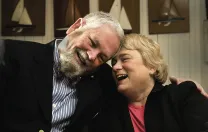Growing up, Brian Newmark ’72 looked at his parents and their married friends and thought “something was missing.” To him, the unions lacked dynamism, the freedom and energy that “led people to grow,” he explains. “It was nothing I was ever drawn to.” That feeling has stuck with him—through three serious, long-term adult relationships and the raising of his now 22-year-old daughter. He and his current partner, Terry Accola, have been together a dozen years, and have bought a home in Lincoln, Massachusetts, but still have no plans to tie the knot.
“One of the nice things about getting old is that it is very freeing: there is a certain letting go of societal dictates, or what others might think of your situation,” says Newmark, a semi-retired psychologist. “Society is definitely tilted toward being a couple and getting married—Social Security and health benefits and tax incentives. People have to be careful not to get married for the wrong reasons: because it’s easier and less expensive. We consciously chose to live together instead.”
They are not alone. The number of heterosexual individuals older than 50 living in “unmarried-partner households” nearly doubled from 1990 to 2006, according to associate professor of sociology Susan Brown at Bowling Green State University in Ohio. “Cohabitation among older adults has increased over the last decade, and since the 1970s, just as it has among younger people,” Brown says. “It’s still a small number, but it is moving only in one direction. The data also suggest that older adults are choosing cohabitation as a long-term alternative to marriage,” rather than a preamble, as is typical for younger adults.
According to U.S. census data that Brown analyzed, 2 percent of that older cohort were cohabiting in 2006 compared to 1.1 percent in 1990. (She notes that the census counts only those who self-report living together full-time.) The over-50 group was also the fastest-growing segment among all the cohabitors categorized by the data, although the 30-39 and the 40-49 age groups contribute greater overall numbers, at 6.6 percent and 4.5 percent, respectively, in 2006.
“Of those who do form a union, one-third choose cohabitation and two-thirds choose marriages,” says Brown, whose work is funded by the National Institute on Aging. The later-life live-ins are also relatively stable, she reports. “The relationship is as likely to end in separation as it is in death, while the average young person cohabits one to two years.”
Confirming that data is a 2007 study published in the Journal of Family Issues, “Age and the Desire to Marry,” which found that “single people at older ages seem to be rejecting marriage,” says coauthor Jenna Mahay, assistant professor of sociology at Concordia University in Chicago. “We expected people in their fifties and sixties to be more likely to want to remarry because of perceived gains (help with children, personal finances, et cetera). And what we found was the opposite: they were less likely to want to marry than their younger counterparts.”
For Linda McJannet, Ph.D. ’71, of Cambridge, living with Michael O’Shea, her partner of 17 years, has had a multitude of benefits. When they first got together, it lessened pressure on their respective children to absorb the new partner, and reduced expectations around family holidays and step-relationships. It has since fostered financial autonomy, helped preserve separate identities, and created a comfortable degree of emotional latitude. “Anyone who has been through a divorce knows it’s a horrible experience—the lawyers get richer and everyone else gets poorer. Nobody wants to go through that again,” she reports. “Living together takes away that sense of ‘should it all go crashing’…presumably it’s not going to be such a painful obstacle to moving on with your lives if we want to. I don’t think we’ll want to, but you never know.”
In fact, she and O’Shea have taken it one step further and live together in a two-family house. They share a bedroom and common space, but maintain two kitchens (great for entertaining and holiday dinners), and divide distinctly personal space otherwise. “The downstairs is his male retreat, where he displays his German bottle stoppers and his baseball collection, and the upstairs is ours; then I have a study on the third floor,” she says. “We think it’s the best of both worlds.”
Both couples interviewed split financial responsibilities, but maintain separate bank accounts, benefits, and retirement funds. “We bought the house together,” Newmark says, “and financially we’re sharing a good system as far as we both put in equal amounts and we balance it out in a way that both of us feel is fair.” McJannet and O’Shea do share some business investments, but those are clearly spelled out in legal terms so there are no misunderstandings. “We both agree that whatever estates we have should go to our children,” she says.
At one point, McJannet thought it made better financial sense to take that trip down the aisle. But a visit to an accountant convinced them otherwise. “At any rate, money is not the best reason to make that additional commitment,” she adds. “We agree we’ll take care of each other and see each other through whatever comes and whatever medical valleys lie ahead. I think the model of cohabiting frees you to think about all kinds of arrangements for living with someone you love most successfully.”






